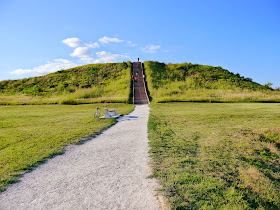Our July 2014 visit to Cahokia Mounds included a 6.2 mile loop walk through the site. The route surface is a combination of concrete sidewalk, gravel path and mowed grass.
The trail starts at the parking lot south of the Interpretive Center. Our first stop was at the Twin Mounds, Round Top and Fox. These mounds are located about 550 yards directly south of Monks Mound and mark the southern end of the Grand Plaza. Fox Mound is rectangular with dimensions of 125 by 160 feet and a height of 45 feet. Round Top is about 100 feet in diameter and is also about 45 feet high. Neither of these mounds has been excavated by archeologists. Based on similar paired mounds at other sites, archeologists speculate that a charnel house stood on Fox Mound and Round Top was a burial mound.
Next, we headed south to Mound 72. This 8 foot high ridge mound located just over ½ mile south of Monks Mound is not oriented to the north like the other mounds. It is about 70 by 140 feet and has been excavated. Radiocarbon dating of some logs gives a date around 950 AD. This mound consists of a series of smaller mounds that were then covered. More than 250 skeletons were found including one buried on a platform of thousands of shell beads. Hundreds of arrowheads that may have come from as far away as Oklahoma, Tennessee and Wisconsin were also found.
The trail continues generally northwest past additional mounds, through the woods and across a field to Woodhenge on the north side of Collinsville Road. From Woodhenge, it heads east past Mounds 44, 42, 41 and 39 before circling the northern side of Monks Mound. From Monks Mound, the trail recrosses Collinsville Road and meanders through the woods around some of the borrow pits before returning to the Interpretive Center.
 |
| Mound 60 or the Fox Mound |
 |
| A short reconstructed portion of the ancient palisade |
 |
| Mound 59 or Round Top Mound |
 |
| Mound 72 |
 |
| This section of the trail was once a paved road |
 |
| The trail enters the woods and wetland area |
 |
| Emerging from the woods, the trail passes two more small mounds |
 |
| Deer grazing on the far edge of the field |
 |
| More deer appear as we cross the grassland |
 |
| The trail is marked by short mown grass |
 |
| Back in the woods, the trail is wide and easy to follow |
 |
| Emerging from the woods, the trail is well maintained |
 |
| Wooden trail markers are located at all junctions |
 |
| The trail continues across a fallow field... |
 |
| ...and emerges in a hay field |
 |
| The trail would be nearly invisible without the trail marker |
 |
| The trail crosses a hay field nearly the size of the Grand Plaza |
 |
| Crossing the field, the trail leads to Woodhenge |
 |
| Beyond Woodhenge, the trail again follows a mowed path |
 |
| Mound 44 just east of Woodhenge |
 |
| Mound 42 or Merrell Mound is dwarfed by Monks Mound on the horizon |
 |
| A house stood on 30 foot high Mound 42 for over 100 years |
 |
| A picnic area is located on the south side of Collinsville Road between Woodhenge and Monks Mound |
 |
| Mound 41 was likely the site of the Trappist Monks living quarters |
 |
| This tree lined lane separating Mound 41 from Monks Mound was likely constructed in the 1800s |
 |
| Deer along the edge of the woods north of Monks Mound |
 |
| More deer in the field northeast of Monks Mound |
 |
| View from the northeast corner of Monks Mound |
 |
| The trail is fairly easy to follow near Monks Mound |
Instead of finishing the trail around the borrow pits, I chose to watch the sunset from atop Monks Mound.
 |
| Downtown St Louis |
 |
| Sunset over a modern day borrow pit |
Entrance to the site is free, but a suggested donation of $7 per adult, $5 per senior, $2 per child or $15 per family.
The historical site website is
http://cahokiamounds.org/.


















































